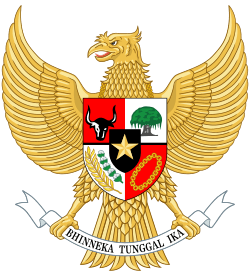1917 Dutch East Indies Volksraad election
Elections to the Volksraad were held in the Dutch East Indies on 16 October 1917.[1] The result was a victory for the Dutch Indies Freethinkers Association, who defeated the Protestant Christian Ethical Party and the Catholic Indian Catholic Party.[2]
 |
|---|
| This article is part of a series on the politics and government of Indonesia |
|
|
Background
The Volksraad was created by a law passed on 16 December 1916 in order to further the possibility of self-government.[3] It had a total of 38 members, half of which were to be elected and half appointed.[4] Seats were also assigned to ethnic groups, with 20 for the Dutch population (nine elected, eleven appointed), 15 for the native population (ten elected, five appointed) and three for the Chinese population (all of which were appointed).[4]
Results
| Grouping | Seats |
|---|---|
| Moderate right-wing | 12 |
| Moderate left-wing | 10 |
| Left-wing | 8 |
| Right-wing | 8 |
| Total | 38 |
| Source: Schmutzer[4] | |
Volksraad members
The subsequent membership of the Volksraad included:[5]
| Position | Member | Notes |
|---|---|---|
| President | Jacob Christiaan Koningsberger | |
| Appointed members | Schumann | Independent |
| Carel Victor Gerritsen | De Javasche Bank | |
| H. s'Jacob | Batavia merchant | |
| Karel Albert Rudolf Bosscha | Manager of tea plantation in Parahyangan | |
| Kettner | Head representative of plantations, Sumatra East Coast | |
| Stibbe | Government resident (official) | |
| Van der Jagt | Assistant resident | |
| Whitlau | Assistant resident | |
| Labberton | Theosophist, Indië Weerbaar propagandist and Home Ruler | |
| A.L. Waworoentoe | Representative of the people of Manado | |
| Atmodirono | Javanese | |
| A. Kamil | Muslim | |
| Sastro Widjono | Javanese | |
| Radjiman Wediodiningrat | Javanese, former leader of Budi Utomo | |
| Achmad Djajadiningrat | Regent of Serang | |
| Koesoemo Oetojo | Regent of Djapara | |
| Koesoemo Joeso | Regent of Patjitan, formerly an official | |
| Abdoel Moeis | Muslim, member of Sarekat Islam | |
| Abdoel Rifai | Muslim, member of the Insulinde party | |
| Elected members | Major Pabst | |
| Josef Ignaz Julius Maria Schmutzer | Roman Catholic, leader of the Indian Catholic Party | |
| Bergmeijer | Anti-revolutionary "christian" | |
| O. van Voorhout | Head of an iron firm | |
| Koning | Head representative of the Koninklijke Paketvaart-Maatschappij | |
| Birnie | Administrator of a tobacco estate in Besoeki | |
| Stokvis | Inspector of Secondary Education | |
| Hok Hoei Kan | Chinese | |
| Lim Pat | Chinese. "Major" of Chinese miners in Bangka Island | |
| Soeselise | Representative of the Ambonese | |
| Frits Laoh | Representative of the Manadoese | |
| Charles Guillaume Cramer | Member of the Indies Social Democratic Association | |
| J.J.E. Teeuwen | Member of the Insulinde party | |
| Tjipto Mangoenkoesoemo | Member of the Insulinde party | |
| Prangwedono | Head of Mangkoenegoro | |
| Tengkoe Mohammad Tajib | Muslim, representative of Aceh | |
| Muhammad Ismail | Muslim, representative of the Arabs | |
| Dwidjosewojo | Javanese | |
| Oemar Said Tjokroaminoto | Muslim, President of Sarekat Islam |
References
- Karel Steenbrink (2007) The spectacular growth of a self confident minority, 1903 - 1942 KITLV Press, p44
- Geert Arend van Klinken (2003) Minorities, modernity and the emerging nation: Christians in Indonesia, a biographical approach KITLV Press, p37
- Eduard J. M. Schmutzer (1977) Dutch colonial policy and the search for identity in Indonesia 1920-1931 Brill Archive, p57
- Schmutzer, p68
- Military Report on the Netherlands' Possessions in the East Indies 1919 p41-42